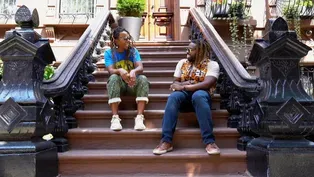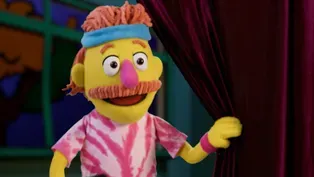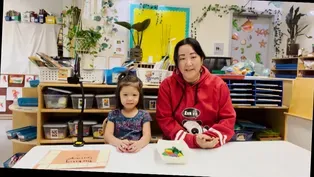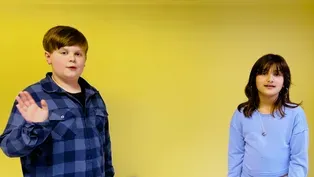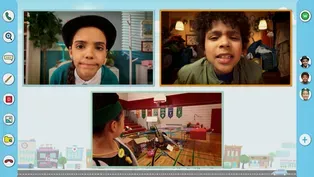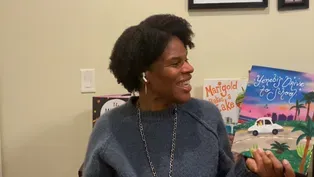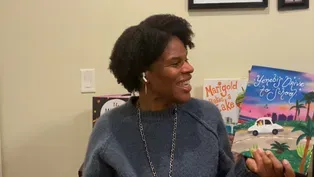
OPEN AND CLOSED SYLLABLES
Clip: 7/17/2024 | 10m 39sVideo has Audio Description, Closed Captions
Learn about open and closed syllables with Isabel Simmons.
Learn about open and closed syllables with Isabel Simmons. Syllables are words or parts of words that can be said in one breath. Practice reading, blending, writing, and building words with open and closed syllables.
See all videos with Audio DescriptionADProblems with Closed Captions? Closed Captioning Feedback
Problems with Closed Captions? Closed Captioning Feedback
Let's Learn is a local public television program presented by THIRTEEN PBS

OPEN AND CLOSED SYLLABLES
Clip: 7/17/2024 | 10m 39sVideo has Audio Description, Closed Captions
Learn about open and closed syllables with Isabel Simmons. Syllables are words or parts of words that can be said in one breath. Practice reading, blending, writing, and building words with open and closed syllables.
See all videos with Audio DescriptionADProblems with Closed Captions? Closed Captioning Feedback
How to Watch Let's Learn
Let's Learn is available to stream on pbs.org and the free PBS App, available on iPhone, Apple TV, Android TV, Android smartphones, Amazon Fire TV, Amazon Fire Tablet, Roku, Samsung Smart TV, and Vizio.
Providing Support for PBS.org
Learn Moreabout PBS online sponsorship[bright music] Open, closed.
Open, closed.
Hi, friends.
My name is Isabel, and welcome to my learning corner.
Today, we're gonna be learning about open and closed syllables.
Syllables are words or parts of words that can be said in one breath, and all syllables have to have a vowel sound.
Are you ready to learn about open and closed syllables with me?
Great.
Let's get started.
Before we begin reading open and closed syllable words today, I'd like us to start with a phonemic awareness activity.
Today, we're going to be listening for the syllables that we hear in words.
Remember, a syllable is a word or a part of a word we can say with one breath.
And that means that we are going to be both listening and feeling what our jaw does.
So I am going to say a word with my hand under the, my chin.
You are going to repeat my word with your hand underneath your chin.
And together, we're gonna figure out how many syllables are in the word.
Are you ready?
- [Students] Yeah.
♪ Stand up - Now you're ready.
Put your hand underneath your chin.
Listen first.
The first word is bat.
You try that.
How many times did your chin go down?
How many syllables did we hear?
One.
Good job.
Let's try another word.
Pencil.
How many times did your chin go down?
Two times.
There are two syllables in the word pencil.
Let's try one more.
The word is vacation.
Can you say that word?
[gasp] How many times did your chin go down?
Three.
We heard three syllables in that word.
Great job.
Now you're ready to read with me.
Now we're gonna begin practicing reading open and closed syllable words.
Before we start, I want to remind you that a syllable is a word or a part of a word that you can say in one breath.
And every syllable has a vowel sound in it.
This word, what is this word?
Men.
Men.
Men!
Men, thank you for helping me.
This word men is a closed syllable word.
Two things are happening you should be aware of.
There's only one vowel.
It's closed in by a consonant.
It could be closed in by more than one.
It's closed in by a consonant, and the vowel is making its short sound.
So that is why the E says e and not ee.
But if we open the syllable, that means we make sure that there's nothing following the vowel E, then the vowel is going to say its name or its long sound.
So what's this word going to be?
Me.
That's right.
Let's try that with another word.
So here we have another word, and gah, I know it's closed.
So the O is going to make its short sound, ah, right?
G, ah, t. Got.
Okay?
And I know that if that's a closed syllable, this is an open syllable.
That means the O is going to say its name or the long sound, which is oh.
G, oh.
Go.
That's why that says go.
It's an open syllable word.
Let's go.
Now we're ready to build one more word.
Let's look at this word.
Is this word an open syllable word or a closed syllable word?
Let me check.
I have one vowel followed by a consonant, which means it's closed.
Yes!
This is a closed syllable word.
That means the I is going to make its short sound.
So let's sound it out together.
H, it.
Hit.
In baseball, the batter hits the ball.
Hit.
Now, how can I change this to an open syllable word?
What do I have to do?
That's right.
If I take away the consonant that closes in the vowel, now my word is an open syllable word.
The I will make its long sound.
H, I. Hi!
Excellent.
That's how I spell it.
Hi.
Now we're ready to read some words together.
Let's read.
Think of our closed and open syllable work today.
Let's answer a few questions before we read.
Which word is a closed syllable word?
Which word is an open syllable word?
Remember, a closed syllable word contains a vowel that makes its sound.
It's also closed in by one or more consonants.
This word is closed.
So it says, mend.
Mend.
This word is an open syllable word.
The E will make its long sound.
This word is me.
Let's look at a few words.
First, we're going to identify if it's an opened or closed syllable word.
And then we're going to read it.
Let's try this one together.
I notice it's closed in by a consonant.
So this is a closed syllable word.
The vowel will make its short sound, a, t. Sound at the word is at.
Now you're ready to read a few more words.
No.
Club.
Brag.
Be.
Chop.
Great job.
Now you're ready to write with me.
We're gonna complete our reading work today with a dictation activity.
So I'd like you to get a paper or something to write on and a pencil or something to write with and come right back.
[bright music] [bright music continues] Are you ready?
Great.
Today, I will say a word, and you're gonna repeat that word to me.
Then we'll tap it together, and you are going to write it down.
Okay?
The word is spend.
When I go to the store, I spend money.
S, P, E, N, D. Go ahead and write that down.
That was fast.
Are you ready?
Sound it out with me as I write.
S, P, E, N, D. Is this what you wrote?
Spend?
Great job!
Friends.
you have done the hardest of the hard work with me today.
I am so proud of all of you.
As you go forward this week, listen in all of the words for how many syllables you hear, and I'll see you next time.
Bye.
Video has Audio Description, Closed Captions
Clip: 7/17/2024 | 3m 31s | With Fyütch, sing "Family Reunion," a song celebrating family reunion traditions. (3m 31s)
FEEL YOUR BEST SELF: SHAKE OUT THE YUCK!
Video has Audio Description, Closed Captions
Clip: 7/17/2024 | 3m 47s | Learn how to “shake out the yuck” when feeling upset. (3m 47s)
Video has Audio Description, Closed Captions
Clip: 7/17/2024 | 4m 17s | Zoe Kleinmann shows how to play a parking garage math game. (4m 17s)
Video has Audio Description, Closed Captions
Clip: 7/17/2024 | 8m 16s | Make a puff mobile using household materials with the Brooklyn Preschool of Science! (8m 16s)
TEDDY AND CHESSIE DO A VOCAL WARM- UP!
Video has Audio Description, Closed Captions
Clip: 7/17/2024 | 1m 34s | Teddy and Chessie show how to warm up vocal cords before singing! (1m 34s)
Video has Audio Description, Closed Captions
Clip: 7/17/2024 | 7m 18s | Create images of vehicles by stamping with paint. (7m 18s)
WORDSVILLE: THE CASE OF THE ORGANIZED CRIME
Video has Audio Description, Closed Captions
Clip: 7/17/2024 | 7m 26s | Athlete Glory's clipboard with the word "organized" on it vanishes! Wordsville is a mess! (7m 26s)
Video has Audio Description, Closed Captions
Clip: 7/17/2024 | 8m 28s | Isabel Simmons reads YENEBI'S DRIVE TO SCHOOL by Sendy Santamaria. (8m 28s)
Video has Audio Description, Closed Captions
Clip: 7/17/2024 | 8m 28s | Isabel Simmons reads YENEBI'S DRIVE TO SCHOOL by Sendy Santamaria. (8m 28s)
Providing Support for PBS.org
Learn Moreabout PBS online sponsorshipSupport for PBS provided by:
Let's Learn is a local public television program presented by THIRTEEN PBS
